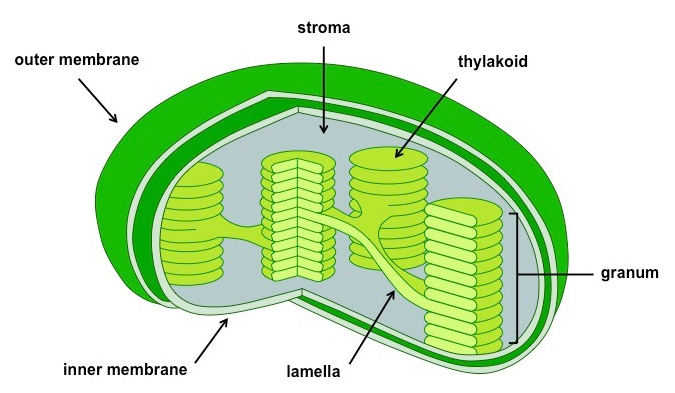Bacteria don’t have chloroplast. They are unicellular single-celled organisms. Their cells are prokaryotic in nature. The cells don’t have membrane-bound organelles. As they don’t contain membrane bound organelles, thus chloroplast being a membrane-bound organelle absent in the bacterial cell.
Chloroplast:
The chloroplast is organelle that is responsible for photosynthesis. They are present in the plants and algal cells. The number of chloroplasts varies from specie to specie. Wheat plants have more than 100 chloroplasts present in the cytoplasm of cell.
Structure:
It is double-membrane structures that are present in the cytoplasm of the . They are lens-shaped organelles that are 3-10µm in diameter and 1-3 µm in thickness. The chloroplast consists of three membrane systems i.e. the one is outer chloroplast membrane, the second one is the r chloroplast membrane and the thylakoid system. Stroma is present in the inside of the outer and inner membrane of the roplast.
They consist of plastids that contain the chlorophyll pigments. They plastids are composed of thylakoid membrane that is stacked over each other to give a pile like appearance. The thylakoid membrane sacs contain the chlorophyll and carotenoids pigments that capture the energy from sunlight. They may contain chromogenic plastids and leucoplast plastids that consist of little amount of chlorophyll in it. This chlorophyll is unable to perform photosynthesis due to low in number. They can move in the plant cell and pinch into two during reproduction of plant cell. They are highly dynamic and circulate in the cell.
Outer chloroplast membrane:
The outer membrane of chloroplast is a semi-porous membrane. These semi-porous membranes allow the diffusion of small molecules and ions from cell to organelle. But, this membrane doesn’t allow diffusion of larger proteins. This predicts that chloroplast polypeptides are being synthesized in the cell cytoplasm and then these proteins are transported across the outer chloroplast membrane. These are transported to the chloroplast by using either TOC complex or Translocon that are present in the outer membrane.
Inner chloroplast membrane:
The inner chloroplast membrane contains stroma. It is responsible for the regulation of passage of materials in and out of the chloroplast. Firstly, these molecules should pass through the TOC complex in the outer chloroplast membrane. Then, these polypeptides pass through the TIC complex that is Translocon that are present on the inner chloroplast membrane.
The inner chloroplast membrane is also responsible for synthesis of fatty acids, lipids, and carotenoids.
Stroma
Stroma is the fluid that is present inside the outer and inner membrane structure. This fluid is riched with protein and alkaline. It is the aqueous solution that is present within the inner chloroplast membrane and outside of the thylakoid space. This stroma is closely related to the cytosol of the original cyanobacterium. It is composed of nucleoids of chloroplast DNA, chloroplast ribosomes, the thylakoid system, starch granules, and many proteins. Stroma is the place where Calvin cycle occurs. Calvin cycle is the cycle in which plant fixes CO2 into G3P
Thylakoid system
These are the components that are suspended within the chloroplast stroma. It is a highly dynamic collection of membranous sacks that is called thylakoids. Thylakoids is the place in which chlorophyll is present. Chlorophyll is responsible for capturing the light reactions of photosynthesis. These thylakoids are arranged in stacks form that forms the pile of membrane which is called as grana. In some plants or algal cells, thylakoids are free float in the cells and don’t form the grana.
Functions:
The functions that are performed by chlorophyll is as follows:
- They have the chlorophyll pigments that are responsible for performing photosynthesis in plants. This chlorophyll captures the energy from the sun and converts it in the form of ATP and NADPH. These energy molecules are needed for the synthesis of organic matter from carbon dioxide during Calvin cycle in the cell. The oxygen released during photosynthesis is released in the air.
- On the other hand, the chloroplast is responsible for the synthesis of fatty acid in the cell.
- It also synthesizes amino acids that make up the peptide chain in the cell.
- It is also responsible for the regulation of the immune response in the cell.
Bacterial photosynthesis:
These bacteria contain chlorophyll pigments that are called as bacteriochlorophyll. These bacteriochlorophyll absorbs the longer wavelength light and converts it into chemical energy. These bacteria use oxygen to accept the free electron from the electron transport chain.
Classification:
There are two types of photosynthetic bacteria.
Oxygenic bacteria:
These bacteria use oxygen to accept the electron from ETC. These bacteria live in aerobic condition. These bacteria release oxygen in the environment. Cyanobacteria are the oxygenic photosynthetic bacteria that prepare its food from the environment.
They are blue-green in colour and lives in water and moist places. They usually form a green layer around the water bodies.
An-oxygenic bacteria:
These bacteria don’t use oxygen for the acceptance of electron. These bacteria allow sulfur to accept the electron in the end of ETC. These bacteria release sulfur in the environment. These bacteria usually live in anaerobic conditions. Purple sulfur bacteria are the an-oxygenic bacteria that are present in anaerobic condition.
CO2 + H2S —-> C6H12O6 + S
These bacteria are usually purple and green in colour. These bacteria are present in the soil.

